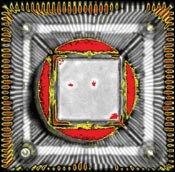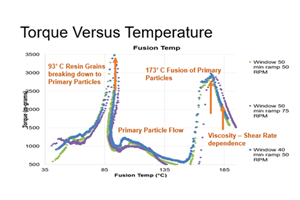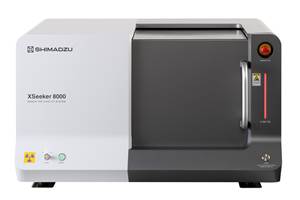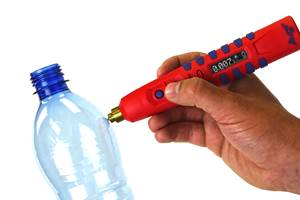Ultrasonic Imaging Finds Voids, Cracks and Bonding Defects
As material costs climb, acoustic micro-imaging (AMI) is increasingly being used for non-destructive inspection and quality control of microelectronic components and assemblies, adhesive and welded bonds, solid part walls, and other applications where bond integrity, cracking, or voids are an issue.
As material costs climb, acoustic micro-imaging (AMI) is increasingly being used for non-destructive inspection and quality control of microelectronic components and assemblies, adhesive and welded bonds, solid part walls, and other applications where bond integrity, cracking, or voids are an issue. AMI analyzes the passage of ultra-high-frequency pulses of ultrasound through a material, which can reveal the presence of internal defects. Voids, cracks, and delaminations are usually associated with air gaps that reflect ultrasound at frequencies of 10 to 300 MHz rather than allowing its further transmission.
Plastics processors are making greater use of AMI due to the higher cost of materials and greater focus on quality improvement. “Companies don’t want to waste parts and they want to confirm that their process can manufacture good parts,” says Steve Martell, manager of technical support services for Sonoscan Inc., which reportedly invented AMI technology in 1973 and makes inspection systems for laboratory and production use.
Picture this bond
Determining the bond integrity between molded plastics and other materials has always been a difficult task for processors. Companies have traditionally relied on cutting a cross-section of the part in order to confirm the bond interface of glued, overmolded, or welded products. This destructive process is time consuming, and it is difficult to extrapolate the data from testing a small number of parts to the overall production process, says Tom Adams, a consultant with Sonoscan.
The benefits of AMI are its non-destructiveness and speed. It can take as little as 5 sec to scan a small part. The C-SAM, or C-Mode Scanning Acoustic Microscope, is an ultra-high-frequency ultrasonic imaging system that looks inside opaque samples and reveals internal features such as defects and construction details.
The system utilizes an ultrasonic transducer that scans the part. Since high-frequency ultrasound does not travel through air, a coupling fluid such as deionized water is used to deliver the ultrasound pulse from the transducer lens to the part surface. The transducer acts as both sender and receiver. A very short acoustic pulse enters the sample and return echoes from interfaces within the part are received at a rate of several thousand times per second. The return times are a function of the distance from the interface to the transducer and the material's acoustic properties.
An oscilloscope display of the echo pattern, known as an A-Scan, shows defects as areas of higher contrast in the image. An electronic gate “opens” for a defined duration, allowing only the information from a specific interface within the part to be imaged while excluding all other echoes. Completed C-SAM images of the internal structure of a sample are produced in about 10 sec.
AMI can be used on parts as large as 18 x 24 ft. A high-resolution scan of large parts can take more than 10 min.
Precise detection
The ultrasonic frequency determines the resolution with which defects can be detected. Generally, a higher frequency means a smaller wavelength and consequently a higher resolution. At 200 MHz, a 10-micron-wide defect can be detected, while at 100 MHz a 25-micron-wide fault is detectable. However, a transducer can actually detect defects an order of magnitude smaller than its resolution limit but not produce a resolvable image, says Martell.
AMI is used extensively in microelectronics where silicon chips are bonded to a plastic substrate. In those applications, AMI is incorporated in-line in the manufacturing process. Sonoscan also sees growing penetration in biomedical applications such as injection molded cartridges. AMI can verify bonds for most plastic materials except fiberglass composites. Acoustic imaging has limitations with high-glass-content materials because of its sensitivity to air gaps.
Sonoscan’s AMI inspection system is suitable for R&D, prototyping, manufacturing QC, and failure analysis. The company’s hardware and software packages range from $175,000 for the base model up to $250,000 with options. Part testing is also offered as a laboratory service in the U.S., Europe, and Far East.
Related Content
Try This Alternate Method for Heating Your Torque Rheometer
Rheometers are generally not on all the time. And most users have found that the first test run in the instrument after heating up is not very reliable and is usually discarded. Try this method instead.
Read MoreDatacolor Acquires Matchmycolor
The acquisition of the specialist in color formulation and communication software further expands Datacolor’s global industry presence in color management.
Read MoreX-Ray Vision Inside Parts Gets More Affordable for Processors
Shimadzu’s new benchtop x-ray CT scanner provides internal and external metrology and flaw detection at a fraction of the previous cost.
Read MoreDual-Mode Portable Thickness Gauge for Packaging
Hand-held “pen” measures sheets, containers, panels, large parts with magnetic or capacitance mode; controlled by Bluetooth phone app.
Read MoreRead Next
Lead the Conversation, Change the Conversation
Coverage of single-use plastics can be both misleading and demoralizing. Here are 10 tips for changing the perception of the plastics industry at your company and in your community.
Read MoreTroubleshooting Screw and Barrel Wear in Extrusion
Extruder screws and barrels will wear over time. If you are seeing a reduction in specific rate and higher discharge temperatures, wear is the likely culprit.
Read MoreProcessor Turns to AI to Help Keep Machines Humming
At captive processor McConkey, a new generation of artificial intelligence models, highlighted by ChatGPT, is helping it wade through the shortage of skilled labor and keep its production lines churning out good parts.
Read More



























